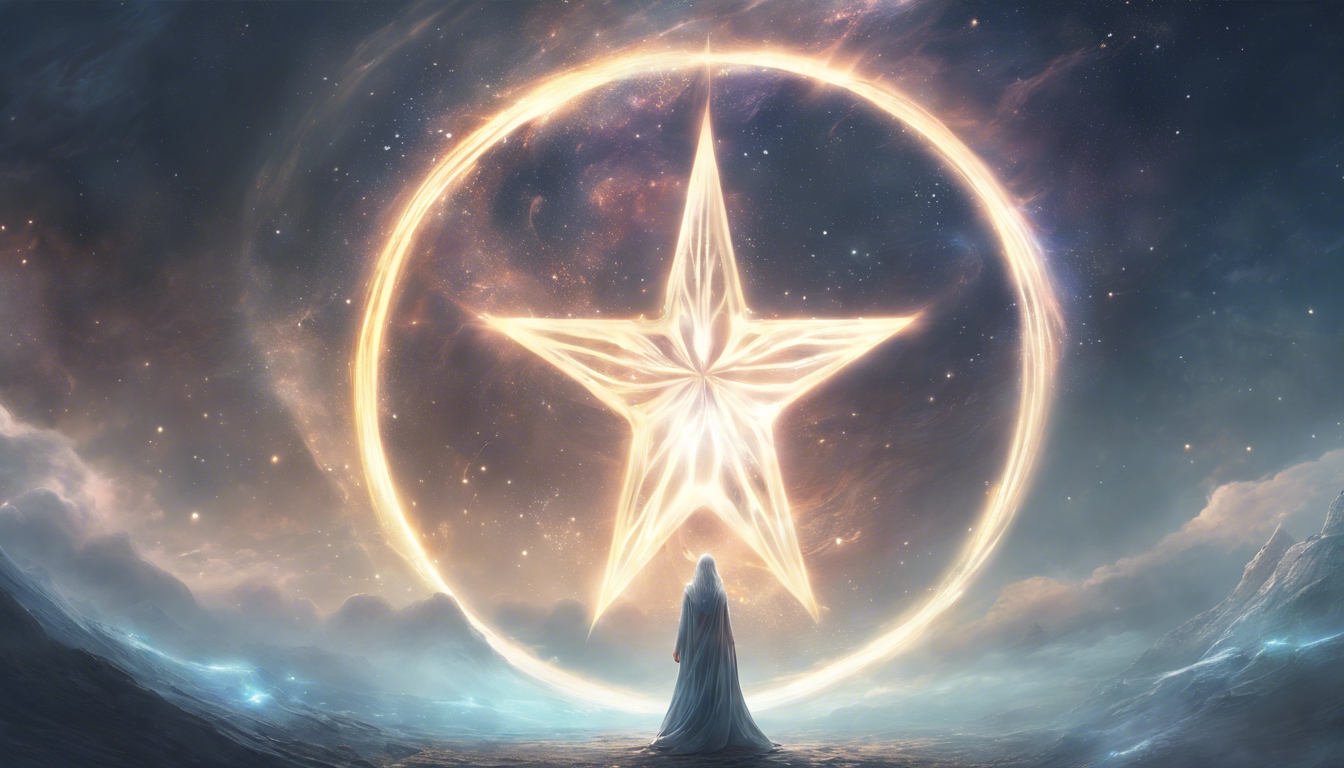The Symbolic Meaning of the Star
The Star in History and Culture
The star has been a symbol used in various cultures and religions throughout history. It holds deep symbolic meaning and is often associated with spiritual and divine forces. From ancient civilizations to modern times, the star has appeared in art, literature, and religious texts, captivating the imagination and inspiring awe.
In many ancient cultures, the star was seen as a representation of celestial beings and deities. It was believed to be a source of guidance, enlightenment, and protection. The star was often used as a symbol to represent the heavens, immortality, and the divine presence.
The Star in Christianity
In Christianity, the star holds great significance, particularly in relation to the birth of Jesus Christ. According to the biblical account, a bright star appeared in the sky, guiding the wise men to the birthplace of Jesus. This star is commonly referred to as the Christmas star or the Star of Bethlehem.
Symbolically, the star represents the divine intervention and the coming of a new era. It signifies hope, light, and the presence of God. The Star of Bethlehem is considered a powerful symbol of faith and a reminder of the miraculous events surrounding the birth of Jesus.
The Star in Hinduism
In Hinduism, the star, known as the “Navagraha,” plays a significant role in astrology and spiritual practices. Each star represents one of the celestial gods or planets and is believed to influence various aspects of human life. The Navagraha is worshipped to seek blessings, protection, and guidance.
Furthermore, the star is also associated with the Hindu god Shiva. The “Nataraja,” an iconic representation of Lord Shiva, is often shown encircled by a ring of flames or stars. This symbolizes the cosmic dance of creation and destruction, as well as the eternal cycle of life.
The Star as a Guide
The star has long been seen as a guiding light in times of darkness. It serves as a beacon, leading the way and providing direction. Just as the stars in the night sky helped travelers navigate their paths, the symbolic meaning of the star represents guidance, knowledge, and enlightenment.
Whether in religious or spiritual contexts, the star reminds us to stay connected to our inner light and trust the guidance of the universe. It encourages us to follow our own path, even in the face of uncertainty, and remain steadfast in our pursuit of truth and wisdom.
The Star’s Many Interpretations
While the star may have different interpretations across cultures and religions, its essential symbolism remains consistent. It represents the spiritual realm, divine presence, enlightenment, and guidance.
The star reminds us of our connection to something greater than ourselves and encourages us to seek higher truths. It is a symbol of hope and inspiration, reminding us to embrace the beauty and wonder of the universe.
In conclusion, the symbolic meaning of the star runs deep across cultures and religions. It represents the celestial, the divine, and the eternal. As we gaze upon the stars, let us be reminded of our own inner light and the infinite possibilities that lie before us.
The Historical Significance of the Star

The Star in Ancient Civilizations
Throughout history, the star has held great significance in various ancient civilizations. In many cultures, stars were considered divine or celestial beings. They were believed to be messengers from the gods, guiding and directing the course of human history. From the Egyptians to the Babylonians, astrological studies were conducted to decipher the meanings and messages hidden within the stars.
The Star of Bethlehem, in particular, is a significant celestial event mentioned in the New Testament of the Bible. It is believed to have guided the Wise Men to the birthplace of Jesus. This legendary star played a pivotal role in the story of the nativity and remains a symbol of hope and divine intervention.
The Star as a Symbol of Guidance
Stars have often been associated with guidance and navigation. In the ancient world, sailors would use the stars as a compass in their voyage across vast oceans. They would navigate by observing the positions and movements of the stars, resulting in successful journeys and new discoveries.
Even today, the concept of “following your star” or “guiding star” remains prevalent as a metaphor for finding one’s true path in life. The star symbolizes guidance, wisdom, and inner light that leads individuals towards their ultimate destiny.
The Star as a Symbol of Hope and Inspiration
In times of darkness and uncertainty, stars have served as beacons of hope and inspiration. During World War II, for example, Jewish prisoners in concentration camps would find solace and comfort by looking up at the night sky. They would trace the constellations and remember that there was a vast universe beyond their confinement.
Stars continue to inspire artists, writers, and dreamers across the world. They represent dreams, aspirations, and the limitless potential of the human spirit. The star spurs our imagination and reminds us to reach for the heavens in pursuit of our goals and dreams.
The Star as a Symbol of Spirituality
For many spiritual seekers, the star symbolizes a connection with the divine and the transcendent. It represents a higher power or cosmic energy that permeates the universe. Stars are often depicted as gateways between the physical and spiritual realms, bridging the gap between the earthly and the celestial.
In various spiritual traditions, stars are seen as guides, offering insights and wisdom to those who seek enlightenment. They remind us of our own inner light and the vastness of our spiritual potential. Stars symbolize the eternal nature of the soul and the infinite possibilities that exist beyond the material world.
In Conclusion
The star holds a rich and diverse historical significance that spans across cultures and time. It has been a symbol of guidance, hope, inspiration, and spirituality. From ancient civilizations to modern-day dreamers, the star continues to captivate our imagination and remind us of our connection to something greater than ourselves. So, let us look up at the stars and be reminded of the infinite possibilities that lie within each of us.
The Cultural Interpretations of the Star

In various cultures around the world, the star has been a powerful symbol with rich cultural interpretations. From ancient times to modern day, the star has held deep significance and meaning. In this article, we will explore some of the different cultural interpretations of the star and uncover the fascinating symbolism behind this celestial icon.
Ancient Civilizations: Divine Guidance and Navigation
In ancient civilizations such as Egypt, Mesopotamia, and Greece, the star was seen as a divine symbol. It was believed to represent gods and goddesses, conveying messages from the heavens to the mortal realm. The star, in these cultures, was a source of guidance, pointing the way and providing navigation for travelers.
For example, in ancient Egypt, the star Sirius played a crucial role in the yearly flooding of the Nile, signaling the start of the agricultural season. The star’s appearance in the sky was seen as a divine blessing, ensuring a bountiful harvest.
Religious Symbolism: Hope and Guidance
In many of the world’s major religions, the star holds significant religious symbolism. In Christianity, for instance, the Star of Bethlehem is believed to have guided the three wise men to the birthplace of Jesus. This story represents hope, guidance, and the divine announcement of a significant event.
Similarly, in Islam, the star, often symbolized by the crescent moon and star, holds deep meaning. It represents guidance and light, leading believers towards the path of righteousness. This iconic symbol can be found on flags, mosques, and various Islamic art forms.
Astrology and Horoscope: Personalities and Destiny
Astrology, the study of celestial bodies and their influence on human behavior, also assigns specific symbolism to stars. Each zodiac sign is associated with a particular star constellation, known as the astrological sign. These star constellations are believed to influence one’s personality traits and destiny.
For example, the zodiac sign Leo is associated with the star constellation Leo Minor and is believed to represent characteristics such as leadership, confidence, and creativity. In this context, the star becomes a representation of a person’s unique qualities and potential.
Modern Interpretations: Fame and Success
In today’s popular culture, the star has taken on a new meaning associated with fame and success. Celebrities in various fields, such as Hollywood stars, sports stars, and music stars, are seen as shining brightly in their respective industries. The star, in this context, represents achievement, recognition, and popularity.
The cultural interpretations of the star have evolved over time, reflecting the beliefs, values, and aspirations of different societies. From divine guidance and navigation to religious symbolism, astrology, and modern interpretations of fame, the star continues to captivate our imagination and serve as a powerful symbol in our collective consciousness.
Whether we gaze at the night sky or see stars adorned on flags and logos, let us remember the diverse cultural interpretations that these celestial wonders hold, reminding us of the universal connection between humanity and the cosmos.


Article written by Dera
Greetings, I am Dera, a 35-year-old individual with a deep passion for spirituality. Through my website, I aim to share my insights and knowledge to help others on their spiritual journey. Join me on the path to inner peace and enlightenment.